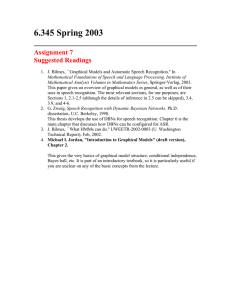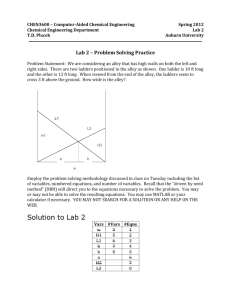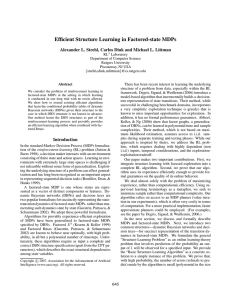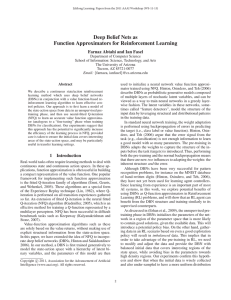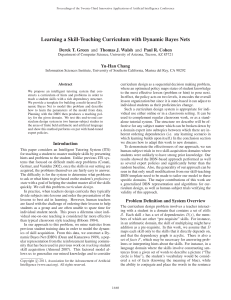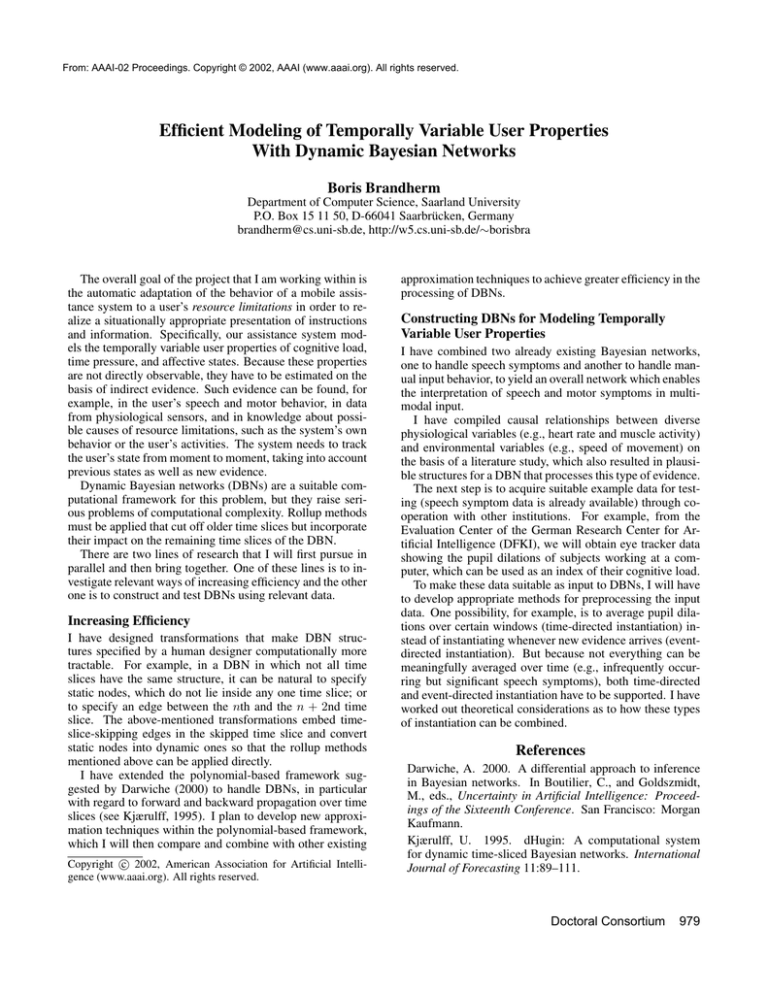
From: AAAI-02 Proceedings. Copyright © 2002, AAAI (www.aaai.org). All rights reserved.
Efficient Modeling of Temporally Variable User Properties
With Dynamic Bayesian Networks
Boris Brandherm
Department of Computer Science, Saarland University
P.O. Box 15 11 50, D-66041 Saarbrücken, Germany
brandherm@cs.uni-sb.de, http://w5.cs.uni-sb.de/∼borisbra
The overall goal of the project that I am working within is
the automatic adaptation of the behavior of a mobile assistance system to a user’s resource limitations in order to realize a situationally appropriate presentation of instructions
and information. Specifically, our assistance system models the temporally variable user properties of cognitive load,
time pressure, and affective states. Because these properties
are not directly observable, they have to be estimated on the
basis of indirect evidence. Such evidence can be found, for
example, in the user’s speech and motor behavior, in data
from physiological sensors, and in knowledge about possible causes of resource limitations, such as the system’s own
behavior or the user’s activities. The system needs to track
the user’s state from moment to moment, taking into account
previous states as well as new evidence.
Dynamic Bayesian networks (DBNs) are a suitable computational framework for this problem, but they raise serious problems of computational complexity. Rollup methods
must be applied that cut off older time slices but incorporate
their impact on the remaining time slices of the DBN.
There are two lines of research that I will first pursue in
parallel and then bring together. One of these lines is to investigate relevant ways of increasing efficiency and the other
one is to construct and test DBNs using relevant data.
Increasing Efficiency
I have designed transformations that make DBN structures specified by a human designer computationally more
tractable. For example, in a DBN in which not all time
slices have the same structure, it can be natural to specify
static nodes, which do not lie inside any one time slice; or
to specify an edge between the nth and the n + 2nd time
slice. The above-mentioned transformations embed timeslice-skipping edges in the skipped time slice and convert
static nodes into dynamic ones so that the rollup methods
mentioned above can be applied directly.
I have extended the polynomial-based framework suggested by Darwiche (2000) to handle DBNs, in particular
with regard to forward and backward propagation over time
slices (see Kjærulff, 1995). I plan to develop new approximation techniques within the polynomial-based framework,
which I will then compare and combine with other existing
c 2002, American Association for Artificial IntelliCopyright gence (www.aaai.org). All rights reserved.
approximation techniques to achieve greater efficiency in the
processing of DBNs.
Constructing DBNs for Modeling Temporally
Variable User Properties
I have combined two already existing Bayesian networks,
one to handle speech symptoms and another to handle manual input behavior, to yield an overall network which enables
the interpretation of speech and motor symptoms in multimodal input.
I have compiled causal relationships between diverse
physiological variables (e.g., heart rate and muscle activity)
and environmental variables (e.g., speed of movement) on
the basis of a literature study, which also resulted in plausible structures for a DBN that processes this type of evidence.
The next step is to acquire suitable example data for testing (speech symptom data is already available) through cooperation with other institutions. For example, from the
Evaluation Center of the German Research Center for Artificial Intelligence (DFKI), we will obtain eye tracker data
showing the pupil dilations of subjects working at a computer, which can be used as an index of their cognitive load.
To make these data suitable as input to DBNs, I will have
to develop appropriate methods for preprocessing the input
data. One possibility, for example, is to average pupil dilations over certain windows (time-directed instantiation) instead of instantiating whenever new evidence arrives (eventdirected instantiation). But because not everything can be
meaningfully averaged over time (e.g., infrequently occurring but significant speech symptoms), both time-directed
and event-directed instantiation have to be supported. I have
worked out theoretical considerations as to how these types
of instantiation can be combined.
References
Darwiche, A. 2000. A differential approach to inference
in Bayesian networks. In Boutilier, C., and Goldszmidt,
M., eds., Uncertainty in Artificial Intelligence: Proceedings of the Sixteenth Conference. San Francisco: Morgan
Kaufmann.
Kjærulff, U. 1995. dHugin: A computational system
for dynamic time-sliced Bayesian networks. International
Journal of Forecasting 11:89–111.
Doctoral Consortium
979

